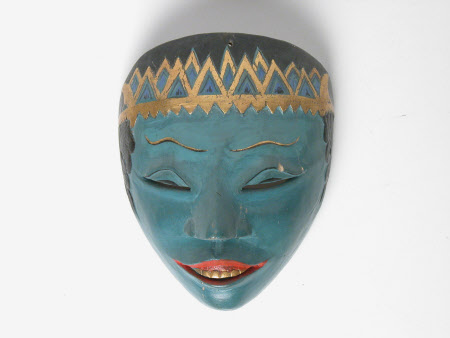Mask
Category
Wooden objects
Date
Unknown
Materials
Wood
Measurements
170 x 141 x 90 mm
Place of origin
Bali
Order this imageCollection
Snowshill Manor and Garden, Gloucestershire
NT 1335611
Caption
This Balinese mask is one of 16 Topeng dance masks in the collection at Snowshill Manor. Topeng (Javanese for mask) originates from around AD 800 and uses dance to tell the story of Siva, the most powerful of all Hindu gods, and symbolises the challenge between good, Barong, and evil, Rangda. This mask would have been worn by the dancer representing ‘Telek Luh’, one of the main characters in Topeng dance. Although the eyes appear sly, her upturned nose and sweet smile represent feminine refinement as spiritual being. Her gold headdress symbolises her royal status and her bold blue colour indicates her high status. The mask also has distinctive short teeth. In Bali, when a child reaches adolescence they undergo a tooth-filing ceremony known as the 'mepandes' or 'metatah' ceremony. The aim of the ceremony is to eradicate the body of the six negative traits – lust, greed, wrath, pride, jealousy and intoxication. Pointed teeth or fangs are deemed to be those of animals and ferocious gods. The mask would have been carved by a craftsman from the 'kepuh rangdu' or pule tree (also known as the crocodile tree) which is light and easy to paint. Non-organic paint is used and made from ground pig jaw or deer horn. While masks made for the tourist trade are thinly painted, high-quality masks use as many as 40 coats, and for a sacred Barong mask, up to 150 layers of paint may be applied.
Summary
Mask from Bali of carved wood painted turquoise all over with slit female eyes with black and gold brows. Mouth showing red lips and gold teeth. Head crowned with circlet of spike design with light and dark blue triangles to centres. Holes for notrils. Hole in top. In notebook no.4, page 46 (1340945.4) Charles Wade refers to: 'Seraphim 140. MASKS 23 specimens WAYANG WONG of carved wood, painted, used by actors dancing & singing the classic KAWI RAMAYANA episodes - also in the TOPENG, Local History Plays, BABAD mostly pantomime with dialogue by the comic actors.' Includes sketch of eyes.
Provenance
CPW Item 140 Given to the National Trust with Snowshill Manor in 1951 by Charles Paget Wade.
References
Wade, 1944: Charles Paget Wade, Contents of Snowshill Manor. Volume 4 First and Second Floor, 1944, page 46
